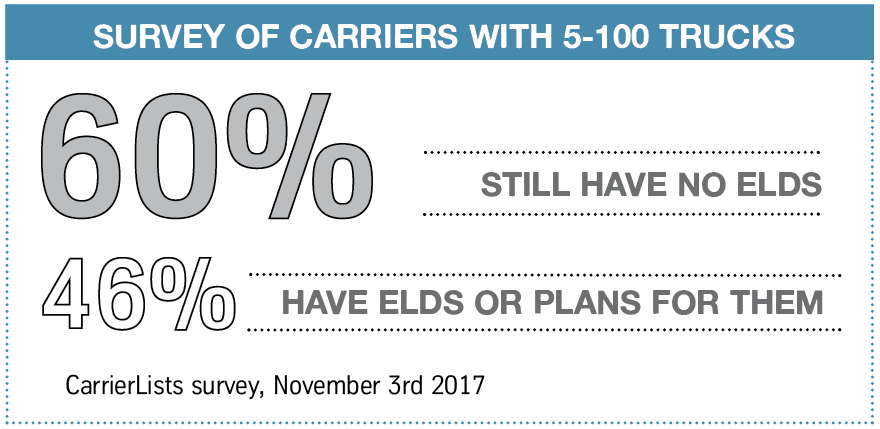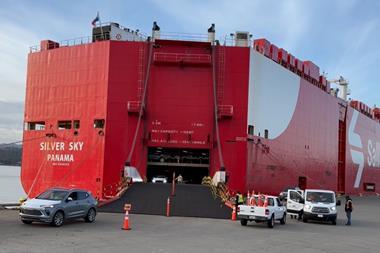 Bob Poulos, chief executive of V3 Transportation, doesn’t need psychic powers to know what has been on the minds of his customers lately.
Bob Poulos, chief executive of V3 Transportation, doesn’t need psychic powers to know what has been on the minds of his customers lately.
As the calendar moves closer to the federal government’s compliance deadline for implementing electronic logging devices (ELDs), most of his expedited trucking firm’s customers – including many in the automotive industry – are concerned about how the regulations, which mandate the electronic logging of driver hours, will impact on capacity across the American trucking market.
“It’s the leading topic of conversation in every customer meeting that we have across all industries, and it’s the first question that we get from customers these days,” says Poulos, who confirms that 40% of V3’s 250-truck fleet operates in the automotive sector. “Customers who utilise trucks, especially those accessing capacity in the expedited market, understand that time is precious. With e-logs, time is going to become even more precious and customers are asking questions to get insights into what the trucking landscape will look like with the entire industry running on electronic logs.”
Similar questions are echoing across supply chains as the December 18th implementation deadline gets closer. After that deadline, the Federal Motor Carrier Safety Administration (FMCSA) has mandated that drivers of trucks with a gross weight over 10,000 pounds (4,500kg) must electronically log their on-duty status, driving time, rest periods and other related activities. For many companies, this will mean moving away from paper-based logging systems that date back to the 1930s.
Electronic logs that track drivers’ activity in real time have been a part of the American trucking landscape for more than two decades, with large fleets among the first to adopt them. The cost and implementation of such systems are not especially high or complex, although they do require some training. However, there has been a reluctance to switch to digital systems because of one of the trucking industry’s worst-kept dirty secrets: paper logs have long presented drivers with the opportunity to omit some of their activities, including driving and on-duty time.

A driver using paper logs, for instance, could conceivably log time lost sitting in a traffic jam or waiting at a customer location as off-duty time – illegally going over the permitted working hours to provide more time in which to drive. The real-time reporting nature of e-logs does not allow for such ‘flexibility’, however, eliminating a common practice and constraining how many carriers, owner-operators and drivers use time and capacity.
The switch to an electronic system with real-time monitoring could therefore impact significantly on overall costs and available trucking capacity. Many small carriers may also not be ready to comply with the regulations in time. This shake-up in the trucking world could have negative impacts for sectors highly dependent on trucking services, too – especially the automotive industry, whose just-in-time supply chains could be put at risk.
At the same time, however, the move should offer both safety and efficiency benefits, as drivers are forced to work only in legal hours and companies gain more visibility over driver behaviour and combine ELDs with other processes, such as tracking of location and vehicle conditions.
This move into more digital processes for the trucking sector suggests that the change to ELDs and to using new technology brings clear risks, but will also have rewards for companies that use them strategically.
Ready for a change to real time, or not?Few, if any, in the trucking industry will admit that they oppose electronic logging because it eliminates the scope to falsify hours of service reports. However, some operations depend on the ‘additional time’ gained through such creative use of paper logging.
Based on the experience of fleets that have made the conversion to ELDs over the years, Bob Costello, chief economist with the American Trucking Associations (ATA), believes that the change will reduce overall capacity. Costello suggests that carriers typically lose 3-5% in productivity, while he says fleets that have yet to make the switch might risk losing more. It all depends on how the carrier operates.
V3’s Poulos – whose 100% owner-operator fleet has been e-log compliant since it started operations in 2013 – also points to capacity challenges as productivity declines. He estimates that a truck has to make $3,000 a week in line-hauls to cover equipment payments, pay the driver and cover other costs like insurance and fuel. Solo drivers can typically achieve those costs points by moving about 650 miles (1,050km) logged on paper.
“But, with e-logging, he won’t be able to ‘stretch’ the time to make those types of longer runs, if there is congestion, [bad] weather, dock delays or other issues,” explains Poulos. “One of the changes that you’ll see is that traffic and supply chain managers will not want to take a risk on anything solo that is greater than 550 miles. We believe that the demand for expedited team capacity will increase. We are already seeing that happen.”
 Andrew Lockwood, a senior manager in Kenco Logistics’ analytics and solutions design group, anticipates that firms will try to ensure a one-day transit time or plan inventories to accommodate two-day solo moves.
Andrew Lockwood, a senior manager in Kenco Logistics’ analytics and solutions design group, anticipates that firms will try to ensure a one-day transit time or plan inventories to accommodate two-day solo moves.
“Under the legal guidelines, a driver can drive 11 hours per day. It’s not as much of an issue in parts of the country, like out west, where drivers can average 55 or 60 miles per hour over the hours that they are driving,” observes Lockwood. “Where there is traffic, congestion, delays, weather or accidents, there will be an impact. Drivers will not be able to go as far in 11 hours.”
Kevin Hill, president of CarrierLists, a service working with more than 400,000 carriers throughout the US and Canada assisting brokerages and shippers, notes that profits for some smaller operations hinge on unlogged time spent in traffic or delayed at docks. Hill is one of many in the industry who believes that ELDs will initiate behavioural changes in terms of how trucking customers operate.
“There are quite a few shippers out there who are very inefficient themselves with their processes, and they are going to need to go through nearly as many changes with what they are doing as truckers are going to make in using ELDs,” he points out. For example, customers who are able to load or unload trucks quicker than competitors could see lower rates than those who cause delays.
The automotive industry, however, with its lean management and just-in-time principles, has a significant advantage in this regard, points out V3’s Poulos.
“Due to the time-sensitive nature of the freight with automotive, you typically have quick turnarounds with less dwell time at the origin and destination,” he says. “Some industries – like consumer products or retail – have improved over the years, but they still don’t compare with the use of time that we see in automotive.”
Contract logistics provider Ryder has around 2,100 of the company’s 7,700-member driving community working within the automotive sector. Steve Martin, vice-president of automotive, aerospace and industrial operations, agrees that the industry is highly desirable in a working environment focused increasingly on tight time schedules.
“Automotive has less volume fluctuations, and carriers are able to build efficient models because they are able to plan on the freight,” observes Martin. “It gives us the ability to have a more a consistent view of where the assets are going to be – something that I think helps carriers manage their business better. There is a need to have high reliability, and that goes back to the level of visibility that has been in this supply chain for a number of years.”
 "With e-logs, time is going to become even more precious and customers are asking questions to get insights into what the trucking landscape will look like with the entire industry running on electronic logs." - Bob Poulos, V3 Transportation
"With e-logs, time is going to become even more precious and customers are asking questions to get insights into what the trucking landscape will look like with the entire industry running on electronic logs." - Bob Poulos, V3 Transportation
Small firms may fall behindMost of the OEMs we contacted for this article either declined to comment or said they expected their carrier base to comply. But automotive manufacturers could still be affected if a large number of carriers miss the deadline.
By late autumn, there were signs that many companies might not be ready. CarrierLists has been polling an expanding database across the company’s roster of member carriers, which range in fleet size up to 100 trucks. Kevin Hill, who has made some of the polling calls himself, says he was in disbelief after seeing the results from initial surveys showing just 23% compliance.
“At first, I thought that the numbers couldn’t be right, but they are accurate. I figured that if carriers are going to give us misinformation, it’s going to be a higher number on the compliance side. But that’s not the case.”
A poll on November 3rd revealed that 60% of survey respondents had not yet installed ELDs. Meanwhile, the rolling average among the 1,900 carriers surveyed to that point that had installed ELDs, or which had made plans to install a compliant system, stood at only 46%.
Kenco’s Lockwood found the survey results to be both fascinating and alarming when considering that the majority of the US trucking market consists of smaller fleets. He cautions companies who might be tempted to dismiss the possible impact of ELD implementation to look again – especially at the risk to small firms not keeping up.
He also says recent surveys showing the industry to be fast on the way to compliance may not have captured the full picture including smaller companies. An oft-quoted Morgan Stanley survey, for example, which suggests the large majority of carriers on track to be compliant, covers 375 companies with an average fleet size of over 1,450 trucks.
According to ATA figures, there are 586,000 carriers in the US, of which 97% have 20 or fewer trucks. “That’s the hidden part of the industry, because all the big boys are touting that they are ELD ready and those are the floating billboards that we see heading down the highway,” says Lockwood. “Anything less than 100% compliance will have major ramifications, and we believe it will fall short of 100%.”
[mpu_ad]No time to quitHow much capacity could come out of the truck market as a result of ELDs is an open question. The ATA’s latest estimates suggest there is already a driver shortage of 50,000, which could be exacerbated. Norita Taylor, OOIDA’s director of public relations, declines to put a number on the level of the organisation’s 158,000 members who may park their trucks up rather than use ELDs, though she admits OOIDA members thinking about retirement may accelerate their plans.
Not everyone is so worried, however. Noël Perry, a logistics economist at Freight Transportation Research Associates, doesn’t believe the dire predictions of a mass exodus following the ELD mandate. Perry contends that, with the combination of constrained capacity from the anticipated productivity losses and rising freight rates, walking away from the industry at this moment of opportunity defies business logic.
“I think the quit-the-industry issue is a red herring. If you have a $100,000 tractor, you don’t throw it away. And you don’t throw it away when we’re in the middle of the highest prices in the last 10 years,” says Perry, referring to the recent recovery in freight rates.
Perry projects a near-term rate increase of 22% on the spot market, and 5-6% on contractual pricing. He points to JB Hunt, one of the largest truckload carriers, which recently sent a letter to customers warning that the company’s freight rates could be increased by 10% or more.
“Those companies that have ELDs in place are licking their chops because this is going to be the last golden age of trucking before we see all the autonomous technology sweep into place,” agrees Lockwood. “From a shipper’s perspective, this is going to be like experiencing a hurricane without the benefit of a weather forecast.”
Digital gainsOverall, compliance is relatively attainable for most. Many ELD solutions are available through a carrier’s in-cab communications system, while stand-alone platforms are available as apps. Scott Sutarik, associate vice-president of commercial vehicle sales for Geotab, says interest in his app-based ELD solution is growing exponentially as the December deadline approaches. Sold as a kit in major truck stops across the US, the app retails for under $200 a unit.
“We’ve been very busy and we expect to be very busy as we get closer the deadline and into early next year,” he says. “We will be working hard to make sure our inventory can meet demand, and we know there’s going to be a high demand.”
 ELD interface and app suppliers have seen an increase in business as the December 18th 2017 deadline approaches
ELD interface and app suppliers have seen an increase in business as the December 18th 2017 deadline approachesIn autumn, Penske Truck Leasing released an app for ELD to all its truck leasing customers, which can also use their own systems. In September, finished vehicle logistics IT provider CDN also released an ELD app, which it subsequently began rolling out in the fleet of vehicle logistics carrier, USAL.
As well as being low cost, both Penske and CDN apps offer other benefits for logistics. Penske’s app helps drivers find service locations, fuel and CNG stations, truck stops and public weighstations, and also allows for the digital submission of fuel receipts. CDN’s app, together with other fleet software, will ultimately provide real-time reporting on freight status, vehicle condition and locations. Such digital gains could point the way towards gains in productivity and operations that could partly make up for those lost elsewhere.
Just another day?Hill is continuing to poll fleets within the CarrierLists’ database as the deadline approaches. The number of small fleets and owner-operators who have not made the transition to ELD-compliant systems may not be known for weeks beyond the deadline, according to the CVSA’s Mooney, as roadside inspections early in 2018 start to yield sampling data for statistical models.
“It’s going to be chaotic. It’s going to depend on enforcement. If people really start getting fined, then it’s going to get worse. No matter how smoothly this comes into place, productivity is going to take a hit. If only productivity takes a hit, that’s probably the best-case scenario. I don’t see any way around that,” predicts Hill.
“The trucking market is kind of like oil – it’s fungible. To ignore those owner-operators and those fleets who make up 97% of the industry is a mistake. If you take out the people that you don’t use, I believe you’ll have intense competition between shippers.”
How smaller carriers respond during a penalty grace period that ends on April 1st (see box below) could reshape the trucking market, of course. Smaller carriers feed into large networks like CarrierLists and Kenco, while also often providing support to larger truckload and less-than-truckload fleets when their ‘in-house’ capacity is committed.
At Kenco, Lockwood notes that the majority of the company’s brokered loads are placed with smaller carriers across its 100,000-truck network. To be a part of Kenco’s network, carriers are tested against a 10-point check system. If carriers that delay implementation are seen as habitual offenders by law enforcement, incurring rising fines and losing time at roadside inspections, they risk exclusion.
 "No matter how smoothly this comes into place, productivity is going to take a hit. If only productivity takes a hit, that’s probably the best-case scenario. " - Kevin Hill, CarrierLists
"No matter how smoothly this comes into place, productivity is going to take a hit. If only productivity takes a hit, that’s probably the best-case scenario. " - Kevin Hill, CarrierLists
Lockwood hopes that trucking customers will also look more carefully at their loading and freight handling operations. “I believe we are going to see a new-found respect for their time and for their occupation,” states Lockwood. “I hate to say this, but a lot of [shippers] just don’t care about the drivers and their time. I believe that will change.”
Ryder’s Martin admits that the overall impact is still unclear, and may require companies to react, particularly in terms of drivers. “I think this is somewhat similar to what we’ve been talking about with the driver shortage. We know it’s there and events make it more acute or relaxed, depending on other factors,” he says. “We’ve been working for a number of years towards this, knowing that these changes help to drive improvements in other ways. We are staying on course with our plan that is tied to the timelines in these new regulatory requirements. I see us continuing with that strategy.”
For all the ELD-related questions Poulos has fielded over the past few months, the easiest has been responding to the intent behind the rule. He has consistently pointed out that the action by the Department of Transportation and the FMCSA is an important step in making the roads safer and putting all carriers on a level playing field.
“The fact of the matter is that there are a lot of cheaters out there, and this has been going on for years. This change will help trucking become a safer industry,” confirms Poulos. “People ask me if I think December 18th is going to be a milestone event. I tell them that I believe it’s going to be another day, but every day forward it’s going to be a new playing field.”
If the December deadline does turn out to have been just another day, things may well change once enforcement begins in earnest next year. At that point, all bets are off.
 Government efforts to encourage trucking firms to use ELDs began at least in the 2000s, while the legal transition to using the technology has been a long process. Their implementation is now characterised by multiple phases.
Government efforts to encourage trucking firms to use ELDs began at least in the 2000s, while the legal transition to using the technology has been a long process. Their implementation is now characterised by multiple phases.
FMCSA’s first full attempt at rulemaking for electronic logging was issued in 2010, but the Owner-Operator Independent Driver Association (OOIDA) successfully challenged the rule in the US Court of Appeals, citing the possibility that carriers could force drivers to drive against their will if the drivers had available hours. In 2014, the FMCSA modified the rule, seeking to address the issues raised in the court’s decision.
The OOIDA filed a subsequent lawsuit against the updated ELD rule but, in a move that effectively ended the legal challenge, the US Supreme Court declined in June 2017 to hear the case, allowing the FMCSA to move ahead with the mandate. In September 2017, the US House of Representatives voted down an OOIDA-endorsed bill that would have delayed implementation until 2019. A similar bill has subsequently been introduced in the House, but appears unlikely to move forward ahead of the deadline.
While the OOIDA has lobbied the Trump administration through various means, including a Twitter campaign under the hashtag #ELDorMe, the White House has shown little interest in delaying or eliminating the mandate. Raymond Martinez, who is expected to be confirmed as the new FMCSA administrator by the end of 2017, stated his support for the ELD mandate during his testimony before the Senate Commerce Committee.
The first phase of ELD implementation has been underway since 2016, which includes voluntary compliance and time to prepare. As of December 2017, carriers must use either a self-certified or FMCSA-approved system. By December 2019, all systems must be approved by the FMCSA.
Enforcement and penalties are also being phased in. For example, the FMCSA will delay putting non-compliant trucks out of service until April 1st 2018. Initial violations will also not be accompanied with the citation of Compliance Safety and Accountability (CSA) points, which are scored against both the offending driver and carrier. This temporary suspension is significant because of how points affect insurance costs. According to Marsh & McLennan Companies’ Shaun Carr, an insurance expert in the trucking industry, a rising CSA score could lead to price increases and eventually be more devastating than the cost of the fines for carriers and drivers.
However, despite the grace period in compliance and points accruals, Collin Mooney, executive director of the Commercial Vehicle Safety Alliance (CVSA) said the enforcement community would begin documenting violations of the ELD mandate from December and might issue citations at the jurisdiction’s discretion. “For the repeat offender, it’s going to cost you time and money. It’s the time for being stopped. It’s the time of having another roadside inspection,” notes Mooney. “There’s been enough notice of this ELD mandate coming. There is no excuse.”
 "For the repeat offender, it’s going to cost you time and money. It’s the time for being stopped. It’s the time of having another roadside inspection. There’s been enough notice of this ELD mandate coming. There is no excuse." - Collin Mooney, CVSA
"For the repeat offender, it’s going to cost you time and money. It’s the time for being stopped. It’s the time of having another roadside inspection. There’s been enough notice of this ELD mandate coming. There is no excuse." - Collin Mooney, CVSA



































